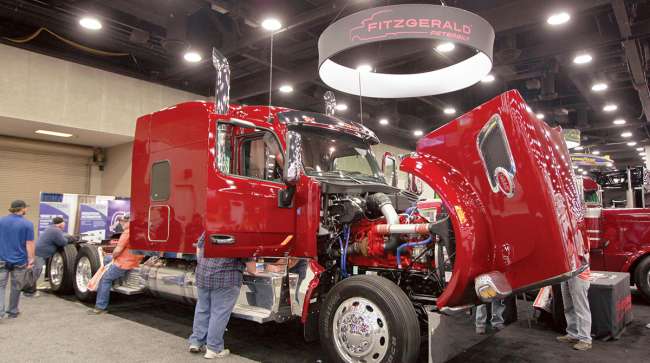Senior Reporter
Limit of 300 Gliders Per Small Manufacturer Suspended, EPA Says

The U.S. Environmental Protection Agency has suspended through the end of 2019 a cap on the number of glider kits that a single builder may produce, the agency told Transport Topics on July 9.
The move lifts the current annual cap of 300 glider kits per manufacturer, a limit instituted during the Obama administration which EPA has proposed to repeal. After reviewing comments on that proposal submitted by stakeholders, the agency determined additional evaluation is needed before a final decision is made, said Molly Block, an EPA spokeswoman.
She added EPA is exercising its enforcement discretion this year and for 2019 as it relates to manufacturers of glider kits.
“Until a final rule can be completed to bring regulatory certainty to glider manufacturers, the agency is considering interim steps to reduce severe impacts on the industry,” Block said, noting an option the agency is considering is extending to Dec. 31, 2019 the compliance date for the 300-unit limit.
In November 2017, the agency proposed to repeal certain emissions requirements for gliders. As Block put it, the repeal proposal “contemplated as alternatives or additional measures an extension of compliance deadlines, and raising the cap on the number of gliders allowed to be built by small manufacturers.”
EPA’s move, first published July 6 in The New York Times, essentially would allow glider companies to sell more than 300 vehicles annually while the agency crafts its glider rule repeal. The agency’s chief, Scott Pruitt, announced his resignation on the day prior.
Tennessee-based Fitzgerald Glider Kits, prominent among small fleet owners, funded a Tennessee Tech University study that concluded glider vehicles with remanufactured engines do not pollute any more than heavy trucks with newer engines.
The university went on to disavow the study after questions were raised about its appearance of partiality. Fitzgerald Glider Kits did not return phone calls seeking comment. Glider trucks are a combination of new truck bodies with older engines.
Union of Concerned Scientists’ director of the clean vehicles program Michelle Robinson called the agency’s action a mistake.
“The last-minute decision to stop enforcing rules limiting pollution from glider trucks is classic Pruitt. It’s arbitrary, unjustified and legally sloppy; it defies scientific facts and the mission of the agency; and it puts human health at risk largely to the benefit of one company,” Robinson said.
The California Air Resources Board told Transport Topics it also was unhappy with the agency’s action. The board would not comment further.
At the start of 2017, small manufacturers were limited to the number of gliders they built in their biggest production year between 2010 and 2014. In 2018, those manufacturers were limited to no more than 300 gliders.
EPA’s 2016 Phase 2 heavy-truck greenhouse gas emissions rule includes the limits to the number of gliders with engines that predate current emissions regulations that can be built by a company annually. The rule also requires certain gliders to be certified as emissions-compliant for the model year they are built.
After Pruitt’s run as EPA chief ended, members of Congress and stakeholders began to focus on his successor. EPA deputy administrator Andrew Wheeler took on the role of acting chief starting July 9.
The freight industry’s aim is to determine how truck-centric the agency will be under new leadership, and also to find out how emissions policy will be handled going forward in President Donald Trump’s administration.
Glen Kedzie, vice president and energy and environmental counsel at American Trucking Associations, said his group is ready to discuss this and other issues with the agency. “ATA looks forward to sharing our industry’s concerns with acting administrator Wheeler and working with the agency to ensure common-sense solutions are achieved,” he told Transport Topics.
Should Wheeler be Trump’s nominee for the top job, he’d likely face a slew of opposition in the Senate. Wheeler lobbied on behalf of coal firm Murray Energy Corp. prior to his confirmation in April to the deputy post, which he won by the narrow margin of 53-45. At EPA, he has vowed to stay clear from former lobbying clients.
“Elevating former coal lobbyist Andrew Wheeler to head the EPA is only trading one fossil fuel friend for another. We must continue to fight the fossil-fuel entrenched interests that have gripped the EPA and want to undermine the public’s health and progress on climate action,” said Sen. Ed Markey (D-Mass.), a member of the Commerce Committee.
Delaware Sen. Tom Carper, ranking Democrat on the Environment and Public Works Committee, emphasized his intention to meet with Wheeler to “understand how he intends to get to work immediately to restore the public’s trust in the Environmental Protection Agency.”
Carper was highly critical of Pruitt’s tenure at EPA. During that 17-month run, critics questioned many of Pruitt’s budgetary decisions, such as first-class air travel.
The environment committee’s chairman, Sen. John Barrasso (R-Wyo.), championed Pruitt’s penchant for rolling back regulations and expressed confidence Wheeler would carry on that legacy.
“I look forward to the confirmation of the next head of the EPA. In the meantime, I know assistant administrator Andrew Wheeler is well-prepared to continue the progress already made under President Trump,” Barrasso said, in a statement issued soon after Pruitt’s resignation.
The Natural Resources Defense Council, meanwhile, launched a campaign on its website calling on Wheeler to “reverse course and protect our clean air and water, combat climate change, defend the fundamental laws that protect our environment and health, and work to restore the effectiveness and public standing of this critical agency.”



